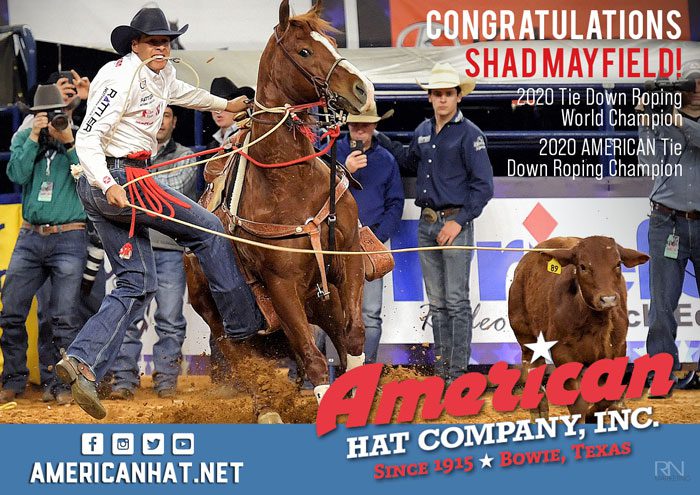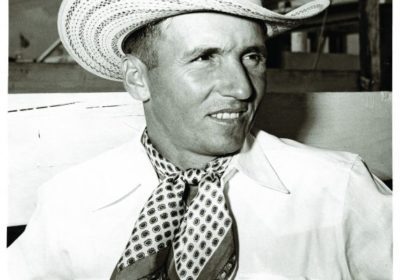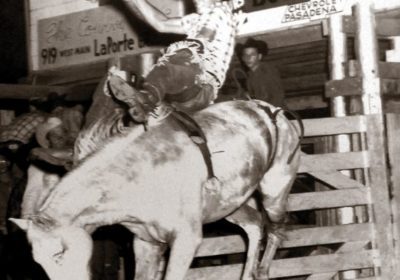Cowboy Kennys Feed and Rope Supplies
Back When they Bucked with Veach Saddlery

Written by: Gail Woerner
< Back to Articles
Monroe Veach was fascinated when he saw his first cowboys. His dad took him to Pawnee Bill's Wild West Show in Saint Jo, Missouri, when he was eight. He was amazed at how they dressed, their horsemanship and ability to rope. He saw a Charro spin a rope like he'd never seen before. Once he got home he began to practice trick roping, he trained his horse to do tricks — he was hooked!
Monroe Veach was born in Missouri in 1896. The frontier had moved westward by then so when he was offered a job to cowboy near Eads, Colorado, in 1916. When he arrived at the train depot he unsaddled and unbridled his horse, slapped him on the butt and his horse headed home. Monroe took the saddle and bridle with him. He didn't tell his family he was leaving. He hopped a freight train and headed west. He knew how they felt about his 'cowboy ways' so he wrote a letter when he arrived in Colorado. The folks thought Monroe's cowboy dreams were a young man's folly and he would grow out of it. Although his father raised sheep and trapped he wasn't surprised at Monroe's choices and accepted his decision.
The following year his cowboy job ended due to World War I. He joined the Army and was sent to Fort Riley, Kansas, to the cavalry division, which he hoped would allow him to utilize his horsemanship skills. Much to his dismay his military time was spent in the saddle and equipment repair shop. Little did he realize how much impact this brief time in the saddle and equipment repair shop would mould his later career and allow him to continue in cowboy fashion. This was the only professional leather-making training he ever got. Monroe's training as well as his creativity in working with leather expanded his horizons.
Monroe left the Army in 1919 and went home to Missouri and started a leather shop in a small building on his home place near Trenton. Mostly repairs on harness, saddles and such kept him busy in the shop. Shortly thereafter he married his childhood sweetheart, Alta. They had six children over a span of twenty years; with Billy, the oldest, Imogene, Mary, Letty, Ben and Peggy, the youngest.
When a friend asked if he could build a western saddle he had enough experience with saddle repairs that he knew he could do it. He made the saddle to the friend's satisfaction. Meanwhile, as his children grew up he introduced them all to the leather-making business and at one time or another they were all trained in various aspects of the business, particularly saddles.
But Monroe had other talents as well. He loved 'The West' and his trick roping talents had expanded. He was asked to entertain at the local movie theater between silent movies. He also joined Foghorn Clancy's rodeo and performed trick roping and trick riding. Trick riding was just getting popular and Monroe could see how necessary and important for the trick riding saddle to be strong enough, with the rider's variety of tricks. They generally always used the saddle as their base. It is not surprising that his children also became fascinated and were passionate about the rodeo world of competition and performing.
His shop on the family place finally became too small for all the work he was hired to do. After a time, 1938, he moved to a location in Trenton on Main Street. The following year, Fred Lowry, a well-known steer roper who had won many of the biggest rodeos in the country, contacted Monroe. Lowry had won a trophy saddle, made by Monroe, and liked it so well he wanted a second saddle made like it with a few minor adjustments. The adjustments Lowry requested were for a stronger saddle than generally made. Lowry roped steers weighing 800 pounds or more and the weight was hard on a regular saddle. Lowry wanted a double rawhide saddle tree for additional strength. Once Monroe had made the new saddle and named it the, "Fred Lowry Roper" the orders from steer ropers all over the country came pouring in.
When World War II began Monroe found that the few companies who furnished a saddle-tree, which is the basis of every saddle, were hard to come by. Most all materials were going to the war-effort and were difficult to get for any reason other than the military. Monroe decided to make his own saddle trees. He used the Linn tree for wood, because it was strong and would not split when nails were used. He brought it to the shop to dry. Letty's husband, George McAlister, ran the first 'tree shop'. Monroe was very innovative in this endeavor, as he was in many things he did through his life.
He tried to get a foundry to produce metal saddle horns, but again the war-effort was using the majority of the metal. Monroe explained he was building saddles for ranchers, the very people who raised cattle to feed the soldiers. Once the company executives heard that they immediately agreed to provide them. "Those boys need beef!" He got their attention, and his metal saddle horns!
Monroe set the standards high in saddle-making. He set the trends for years to come and demanded a product (saddle) that was not only functional but of the best materials. He became the premier trick riding saddle-maker and had as many as ten people working in his shop. Having been a trick rider he had an edge on knowing what was most important in the development of trick saddles and made sure they were of the finest quality. Today an old Veach trick riding saddle is an important find, but a retired trick rider will seldom let their Veach saddle go.
Monroe and son, Billy, produced rodeos by Veach Rodeo Company. While Monroe ran the shop, Billy did the ramrodding of a rodeo but Monroe would perform, and act as secretary and timer. Other family members were always present to handle a variety of duties and responsibilities required to put on a good rodeo. At one of the rodeos son-in-law George McAlister was the announcer, and just prior to the Saturday night rodeo, a deluge of rain came and the performance had to be postponed until Sunday. George couldn't stay over until Sunday afternoon because he had to head back to Trenton. When he let Monroe know he enlisted Clem McSpadden to take over his first announcing chores.
The Veach Saddlery grew and a boot department was added. His daughter, Imogene loved working in the shop and learned to weave cinches and stitching boot tops on a treadle sewing machine. In time, she got to do more intricate designs made by Monroe. He always had a pencil handy and once he created a design Imogene would then stitch it out.
When Peggy was ten or eleven, she recalled the pony business was booming and a gentleman in the Midwest had a large pony ranch and held a two day sale every year. He commissioned Veach Saddlery to make pony halters out of white latigo leather so each pony he sold was wearing a white halter at the sale. Monroe had all the leathers cut, and Peggy could put together a gross (144 halters) in a day. Peggy remembered her dad took her to the pony sale one year and saw all her halters leaving the auction area on those ponies. The Veach Saddlery was truly a 'family affair'.
When Robert Robinson, Peggy's husband, went to work for Monroe he built saddle trees. Robert remembered being taken to the tree shop, and Monroe showed him the patterns, the band saw, and described the process of making a saddle tree. "When I went to ask a question I turned around and Monroe was gone" recalled Robert. "He let his employees learn from their mistakes," said Robert and Peggy's son, Craig, who also has been on the payroll since he was fourteen. Monroe never got mad. He'd just say "Don't let that dog bite you again."
Veach Saddlery sold to numerous dealers across the country. They began putting out a catalog of their various leather goods and inventory. Robert Robinson was their salesman and he traveled and called on dealers in Iowa, Illinois, Kansas, Oklahoma, Missouri and Indiana. They also had a booth at the Western Market in Denver in the 1960s and 1970s. Other dealers ordered from the catalog. The last catalog was sent out in 1983 and was #14.
In 1976, the Bicentennial USA year, Monroe went to the Smithsonian Institute in Washington D. C. at their invitation to do a saddle-making demonstration. It was held near the Washington Monument Mall and in addition to the saddle that he made there, he brought a completed 'Bicentennial' saddle that he gave to the Smithsonian. Bryan Dew, a film-maker from New Zealand, attending the event watched Monroe build the saddle. Visiting with Bryan, Monroe's passion for the West became evident and Dew began an extensive film shoot featuring Monroe. Dew and his crew worked on this project for ten years. Although it took longer to complete than Dew had anticipated Peggy remembers that it was her job to keep Monroe in the same shirt, hat, etc. – – – for the ten year span so the resulting documentary looked like it was done in a brief length of time. "A Ten Dollar Horse and a Forty Dollar Saddle" was the result, and was released in 1986. It was all about Monroe and his talents in the leather-making industry, his love of rodeo and performing as a trick roper, and telling tales of the West and so much more. When it was completed Dew learning that Monroe was ninety years old, and not in good health, hurried to Trenton and the film was shown at the local junior college for the entire community. Monroe passed away that year on Christmas Day. Two years later "A Ten Dollar Horse and a Forty Dollar Saddle" was given a Bronze Wrangler Award by the National Cowboy & Western Heritage Museum in Oklahoma City, OK. In 1993 Monroe Veach was inducted to the Rodeo Hall of Fame there as well.
Veach Saddlery has continued to prosper, with Peggy, husband Robert and son Craig in charge. Things have changed somewhat but the basic principles taught family members, spouses and friends have never been forgotten. In fact, knowing how far-reaching Monroe's creativity and his love of the West have spread, it seems the entire family can be called 'Throwbacks'. The definition of throwback is: 'a return to a former type or ancestral characteristic'. A tradition in the family of Monroe Veach and his talents and desires that have carried over and influenced the lives of each and every generation since then.
Peggy, Robert and Craig, have continued to build saddles and leatherworks. Craig started his career sweeping floors. He has moved up to the responsibility of becoming their custom saddle expert. Peggy, who has kept her dad's books which include the list of saddles by serial number (which is the actual number of the saddle made at the shop) remembered that in 1932 the first trick riding saddle was made for Lucyle Richards, a beautiful trick rider and lady bronc rider that the family kept a friendship with for her lifetime. Peggy also reported that the last saddle finished at the end of 100 years was number 18,949!
In their spare time the Robinsons have been ropers. In fact, Peggy, cut her thumb off roping, a common roping injury. Fortunately, she was able to have it reattached. They also attend and keep up with the rodeo world and the people in it, not only in their home state but across the country and in Canada. Through the customers they have satisfied during the past century they can name people from every state, as well as Canada, and they have sent saddles to Belgium and South Africa.
Billy, Munroe's first born, put on rodeos until he was killed in a truck accident in 1957. Many members in the family came together to complete his rodeo contracts, after his demise, then sold the rodeo stock. Billy's sons, Kenny and Cary both worked in Monroe's shop, and now have their own shops. Kenny Veach Custom Leather is in Mount Vernon, Missouri. Cary after being a saddle bronc contestant makes and repairs rodeo equipment for the roughstock events, and is located in Ankeny, Iowa.
Roughstock rider, Charley Beals, married oldest daughter, Imogene, and once World War II was over Charley worked for Monroe and learned the trade. In 1945 they opened Veach Saddlery in Tulsa Oklahoma. Rodeo cowboys traveling through Tulsa never hesitated to stop at the shop and say hello. Charley and Imogene had one daughter, Donna Kay. She married Duke Clark, a roughstock rider from Trenton, who also trained horses, played polo, and has competed in pulling horse contests and presently ranches. Duke did work in the Tulsa shop and Imogene trained him to tool and make saddles. Charley retired in 1985 and closed the shop. In 2007 their grandson, Drew re-opened it at Colcord, OK. One of his specialties is the Doug Clark Roping Saddle. Doug, another grandson, was All-Around Cowboy at Cheyenne Frontier Days and Steer Roping Winner at Pendleton RoundUp, two of the largest, prestigious rodeos in the country. He also trains timed-event horses and has had horses he trained in National Finals rodeos every year for over 35 years. Doug and wife Linda's daughter, Darcy, and her husband, Billy Good are roping presently and doing well. Third grandson to Charley and Imogene, Derek, was a saddle bronc contestant and qualified for the National Finals Rodeo fifteen times.
Mary, second daughter of Monroe, and husband Al Cunningham, had a Veach Saddlery shop in Branson, Missouri, for a time. Both are deceased. Letty, Monroe's third daughter, and husband, George McAlister, not only handled the tree shop in the beginning for Monroe, but also announced rodeos for the Veach Rodeo Company. Letty in her younger years was a trick rider and she and her three sisters were always available when Monroe did his trick roping horse catch of the four girls.
Ben, Monroe's youngest son, invented a stainless steel, one piece, stirrup buckle. He was the rodeo clown in the 1940s rodeos for Veach Rodeo Company .
Throwbacks, each and every member of Monroe Veach's family and their off-spring and the next three generations are connected in some way to the world he created. When interviewing these individuals their answer to the question: "Have you ever considered doing anything else?" The answer is always the same, "No, why should I? I love what I do."
A hundred years later there is no question to the stability of Veach Saddlery in Trenton, Missouri, and the others scattered around the country that came from Monroe's passion for the cowboy life. The legacy he created and left has only expanded the commitment and desire for saddle-making, trick roping, trick riding, and competing in rodeo. Some of his youngest family members may not do it all, but they at least are involved in one or more aspects of the life he lived.
Monroe Veach was posthumously inducted to the National Cowboy & Western Heritage Museum's Rodeo Hall of Fame in 1993. His son-in-law Charley Beals was inducted in 2010. His great-grandson, Derek Clark was inducted in 2018. His daughter, Imogene was the recipient of the Tad Lucas Memorial Award, and his great-grandson, Doug Clark was the recipient of the Ben Johnson Memorial Award. These honors were bestowed on these members of Monroe and his family because "they loved what they did for a living". Can it be any better than that?

Source: https://rodeonews.com/back-when-they-bucked-with-veach-saddlery/









0 Response to "Cowboy Kennys Feed and Rope Supplies"
Postar um comentário